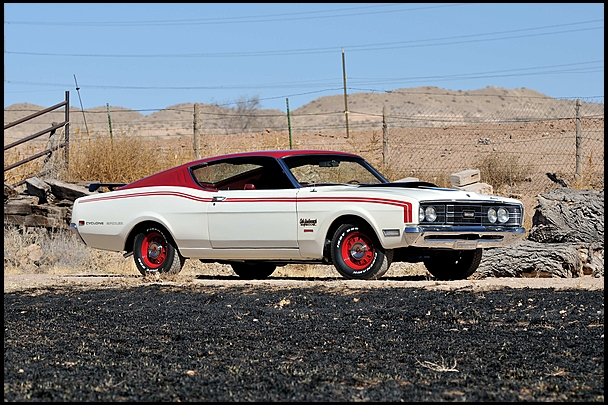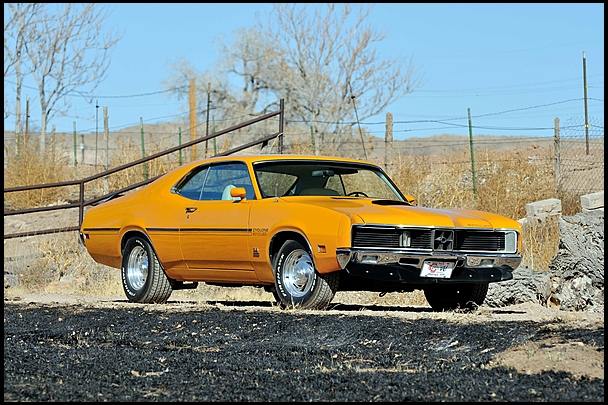CLASSIC CARS: Mercury Cyclone for Dummies
 |
| 1970 Cyclone Spoiler |
 |
| 1970 Cyclone GT |
 |
| 1969 Cyclone CJ |
 |
| 1969 Cyclone Spoiler |
As under-appreciated muscle cars go, the enigmatic Mercury Cyclone is about as obscure as they come. But I still love them.
First of all, “Cyclone" was a cool name. Most modern car names are garbage. The Intrigue wasn’t. The Hummer didn’t. The Citation couldn’t go fast enough to earn one. The Probe… well… insert your own joke here. And every Prizm, Tempo and Aztec ever built should be loaded aboard the Enterprise, launched into space and used for photon torpedo practice.
But “Cyclone" was an awesome name for a car. And today, that car is shockingly affordable and among the best buys on the muscle car market.
Let us now delve into the mysteries of this wonderful machine with a brief, general discourse on chronology and basic identification.
Many listings only mention the Cyclone beginning in 1968, when technically, the Cyclone was introduced as a sub-model under the Mercury Comet (another cool name) in 1964. The Cyclone became a separate nameplate in the Mercury lineup in 1968; hence the confusion. The 390 cubic inch V8 engine was standard equipment for the GT version in ‘68.
A new “CJ" model became available the following year. Offered only in ’69, the CJ came with a special handling package, four-speed manual transmission and a 335-hp 428 engine that actually produced nearly 500 horsepower. The one-year-only CJ was truly a wicked street machine and remains among the most desirable Cyclones on the classic car market.
The smokin’ hot Cyclone instantly drew the attention of Mercury executives who wanted to cash in on the growing popularity of NASCAR racing. After all, Ford’s high-winding 429 big block engine was available and the Cyclone was already blessed with the aerodynamically friendly “Sportsroof" (Ford’s commercial name for the fastback configuration). A marriage with the 429 seemed the perfect means of whacking the competition in NASCAR.
So Mercury hopped up the model’s image with the new Cyclone “Spoiler" in 1969. Optional engines included the 351, 390, and the stupid fast 428 with Ram Air package. The car was an amazing street machine with any engine, but the 428 Cobra Jet-equipped Cyclone Spoilers were simply off the chart.
Yet from a competition standpoint, there remained one big problem. The Cyclone (including the Spoiler version) had an extremely peculiar front grill that featured receding concaves inside each headlamp. These concaves were a styling hit with the public but an aerodynamic nightmare on the racetrack, collecting huge amounts of air at high speeds in parachute-like fashion.
Mercury engineers solved the problem in the most simplistic way. They re-designed the Spoiler’s nose. The new front end was longer and included a new, straight grill that was slightly narrower and eliminated the concaves entirely. The result was dubbed the “Cyclone Spoiler II," and it was this body style that would go into action on NASCAR tracks.
 |
| 1969 Cyclone Spoiler II nose, showing the difference between the standard Spoiler |
Both the Spoiler and Spoiler II were available in street versions. Surviving cars are easily distinguishable by checking the front end. The concave, “W grill" cars are Spoilers; those with flat noses are Spoiler II’s.
On the track, the NASCAR version of the Cyclone Spoiler acquitted itself well by scoring eight wins in two seasons despite the dominance of the legendary Plymouth Superbird.
But in 1970, both the Spoiler II and the CJ were dropped from the Cyclone lineup. The Spoiler II fell victim to NASCAR rules that rendered the aero cars obsolete. The CJ was destroyed by unelected government busybodies bent on preventing humanity from having any fun.
Still, the Cyclone didn’t go down without a fight. The Spoiler remained in production and was now available with a stripped down, emissions-approved version of the once-mighty 429.
The GT version was also available in 1970 with a sporty trim package and an assortment of engine options.
 |
| 1971 Cyclone GT |
By 1971, sales were waning and the Cyclone was no longer a stand-alone model. The only way to get one was to order a Mercury Montego with the Cyclone option package. And there was no chrome Cyclone badge to be found anywhere on the car. The Cyclone name was recognized only by a small decal just behind the wheel on the front quarter panels.
The 351 Cobra Jet was now the top engine option as government regulators slowly strangled the performance market to death. By 1972 the party was over. The Cyclone disappeared from the Mercury lineup.
The most sought-after models today are the Spoiler and Spoiler II versions. The 1968-70 GT’s are a relative steal, with pristine models available for under $20,000.
If you’re in the market for a unique, authentic muscle car with killer performance at a bargain basement price, the Mercury Cyclone will be hard to beat. Here is a list of Cyclones that sold at the Mecum auction in Houston last weekend:
• 1968 Cyclone GT with 390 engine and 4-speed manual transmission, $16,000
• 1969 Cyclone CJ with 428 engine and automatic transmission, $19,000
• 1969 Cyclone Spoiler with 428 engine and 4-speed transmission, $26,000
• 1969 Cyclone Spoiler II with 351 engine and automatic transmission, $22,000
• 1970 Cyclone GT with 429 Cobra Jet engine and 4-speed transmission, $20,000
• 1970 Cyclone Spoiler with 429 Cobra Jet engine and automatic transmission, $30,000
• 1971 Montego Cyclone with 351 engine and automatic transmission, $24,000
Stephen Cox

